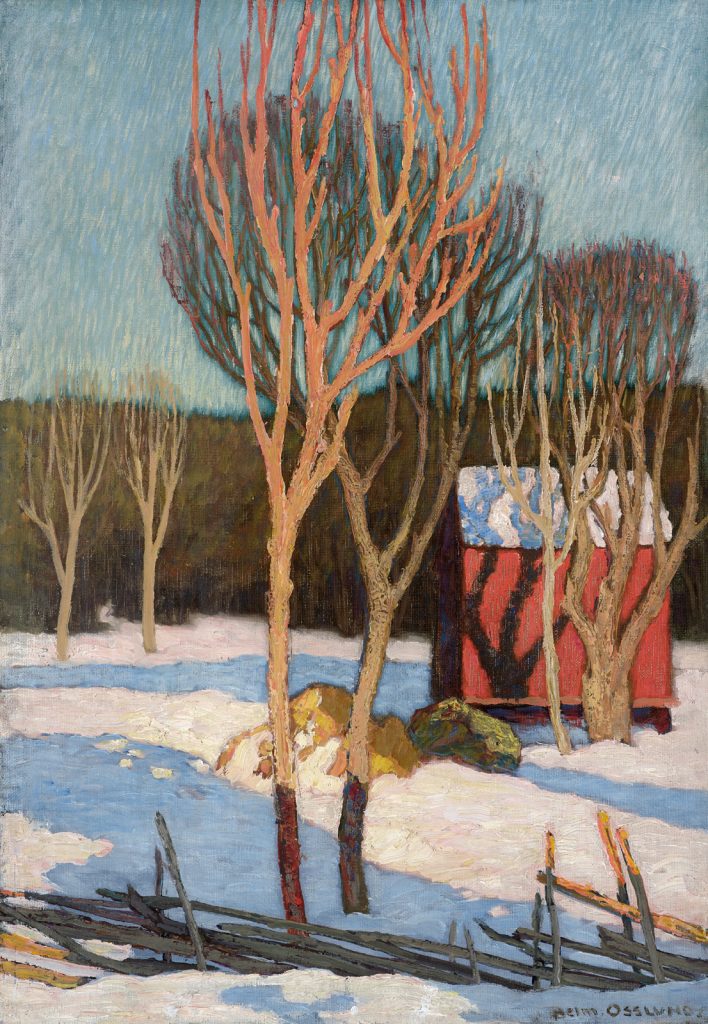Helmer Osslund
(Tuna, Medelpad 1866 - 1938 Stockholm)
A Sunlit Winter Landscape, Sweden, before 1900
Oil on canvas, 48.5 x 34 cm
Signed lower right Helm. Osslund
Provenance:
Private collection, Sweden.
The topography of northern Sweden was Helmer Osslund’s lifelong focus of interest.1 His preferred motifs were drawn from the landscapes of Norrland and the historic province of Lapland in the far north of Sweden. This remote region had largely escaped artistic notice until it was discovered by painters in the late nineteenth century. This led to the emergence of a new style of landscape painting far removed from the Swedish capital.2The shift of artistic focus away from urban areas was a Europe-wide phenomenon in the 1880s and 1890s, while the search for pristine, unadulterated nature and intact cultural traditions had a global dimension. No artist pledged himself more unconditionally to this than Osslund’s teacher Paul Gauguin (1848-1903). Dissatisfied by his stay in Brittany he left France for the South Sea island of Tahiti, fleeing modern civilization in search of an authentic lifestyle in an unspoiled tropical paradise.3
Osslund moved to the United States in 1886 to study engineering. While living there he changed his last name from Åslund to Osslund to ease pronunciation in his new country. He returned to Sweden and in 1889 began an artistic career as a porcelain painter in the Gustavsberg porcelain manufactory. In 1890, his employers funded a study trip to Paris. But rather than return, he resigned from his job. Like many of his Scandinavian fellow artists his aim was to further his artistic skills. He moved to Paris in 1893 and enrolled at the Académie Colarossi. In Paris, he met and was intermittently taught by Gauguin from 1894 until Gauguin sailed again for Tahiti in the summer of 1895.
This Winter Landscape is an early work executed soon after Osslund left Paris.4 Although his style never lost its profoundly Swedish flavor, in its formal aspects at least, his work is deeply indebted to Gauguin. He shaped and altered what he found in Gauguin’s ‘innovative handling of color, plane and pictorial space, together with the subjective, spiritual and symbolic dimension of his images’5 Breaking free from purely naturalistic reproductions of the visible world, he produced a radically simplified portrayal of Swedish landscape, lending it a decorative element and using bold, flattened fields of vibrant color to structure his compositions. Like many of his contemporaries, he blended his subjective experience of nature with contemporary national influences to produce a ‘synthesis of French formal language and Nordic sentiment.’6
Groups of tall, slender trees dominate the present composition, emphasizing its vertical format. Their leafless branches stretch resolutely upward and are partly truncated by the upper edge of the image. The compositional structure and palette are harmoniously balanced. Osslund’s interest focuses on the contrast between the muted tones of areas of shadow and the glare of sunlit areas. Patches of cool bluish-white create coloristic interplay with the warm rust-red and brown of the shed, the trees and the fence.
Osslund traveled to Norrland in the far north of Sweden in 1899. It was here that he discovered the motifs that were to be central to his artistic career – the remote, untamed countryside of the ancient province of Hälsingland and the landscapes close to the rivers Ljungan and Indalsälven. In 1905 he moved further north to Lapland.
1See A mirror of nature. Nordic Landscape Painting 1840-1910, exhib. cat., Copenhagen, Statens Museum for Kunst; Helsinki, Ateneum Art Museum; Stockholm, Nationalmuseum; and Oslo, The National Museum of Art, Architecture and Design, 2006, p. 290; Torsten Gunnarsson, Nordic landscape painting in the nineteenth century, New Haven (and elsewhere), 1998, pp.247-52; Helmer Osslund: norrlands målare, exhib. cat., Stockholm, Nationalmuseum, 1971.
2 Michelle Facos, Nationalism and the Nordic Imagination. Swedish Art of the 1890s, Berkeley 1998, p. 189.
3 Landschaft als Kosmos der Seele. Malerei des nordischen Symbolismus bis Munch 1880-1910, exhib. cat., Cologne, Wallraf-Richartz-Museum, 1998, p. 80.
4 Osslund left Paris for Sweden by way of Germany, Holland and Scotland in 1898. On his return to Sweden he studied briefly at the art school of the Artists’ Association in Stockholm but broke off his studies to travel to Norrland in the far north of Sweden in 1899.
5 Paul Gauguin, exhib. cat., Fondation Beyeler, Riehen/Basel, 2015, p. 29.
6 Landschaft als Kosmos der Seele, op. cit., p. 79.

